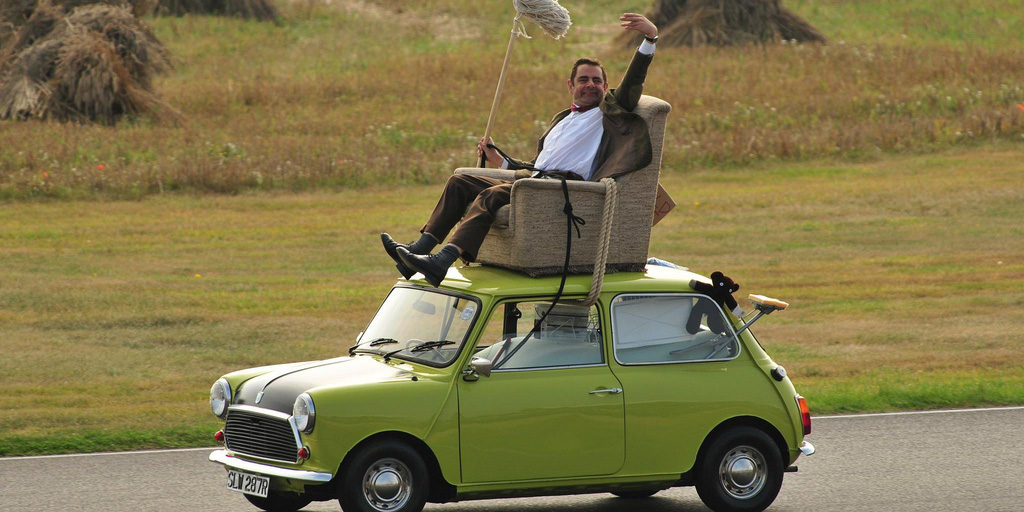Unsere vernetzte Welt verstehen

Wie gestalten wir die Zukunft der Mobilität?
Das Silicon Valley ist bekannt für seine langen Staus, die das tägliche Leben der Bewohner der sogenannten Bay Area, südlich von San Francisco, nachhaltig prägen. Kein Wunder, dass das Silicon Valley sich zum Testgebiet für futuristische Mobilitätslösungen entwickelt hat. Transformation im Mobilitätsbereich wird zum einen getrieben durch einen Anstieg von “shared-mobility” Lösungen und zum anderen durch die Weiterentwicklung von autonomen Fahrtechnologien. Jessica Schmeiss, Doktorandin am HIIG, beschäftigt sich mit folgenden Fragen: Welche sind die Treiber und Herausforderungen der neuen Mobilitätslösungen und inwieweit sind diese Lösungen auf verschiedene urbane Gebiete weltweit übertragbar?
Silicon Valley reality
It is 4pm on a Tuesday night, I am in my car, driving from Palo Alto, the epi-center of Silicon Valley, to Santa Clara for a networking event. The distance is a little more than 20 km and it took me just over 20 minutes to get there last weekend. Given that I am new to the Bay Area, I was not really thinking about traffic during the week and did not realize that the same distance would take me about 60 minutes during the week. Quickly realizing that there is nothing I can do, I called my friend and tell her that I will be late. She answers: “Oh, I was surprised that you were coming anyways. Traffic is terrible at that time, I would have stayed home.” It is not the first time that I hear someone say that – it seems like traffic defines a big part of everyday life for people in the Bay Area. Some even commute up to 2h one way, 5 days a week, depending on where they live and work. On average, a US citizen currently spends 46 minutes per day commuting in a car.
Knowing that, it is not surprising that companies like Tesla and Waymo – formerly the Google self-driving car project – chose the Bay Area as a test bed for their autonomous or semi-autonomous vehicles in the “backyard” of their headquarters. And sure enough, I run into two Waymo cars on my way to Santa Clara.
The strong need for a new, more efficient and pleasant mobility solution in a metropolitan area such as the Bay Area is quite obvious. However, the question arises, how and when autonomous and electric driving technologies can realistically solve these challenges and if the solutions developed here also apply to other metropolitan areas around the world.
By now, there is a widespread agreement, that the mobility sector is about to change dramatically and that this transformation will require a number of stakeholders such as industry incumbents, disruptive tech companies and regulators working together to put the emerging opportunities into action. The future of mobility largely depends on the development of two factors (Deloitte, 2017). First, the extent to which vehicles continue to be personally owned or shared will determine in what capacity our current mobility ecosystem changes. Second, the willingness of consumers to adopt autonomous driving technology and give up the control, status, and pleasure that comes with driving their own car will determine how fast the technology transforms mobility. Incremental change is expected to happen if one of the two factors will prevail – for example the mass adoption of personally owned autonomous vehicles or a “world of sharing”, enabled by current players such as Uber or DriveNow. True radical change in the sense of a completely concept of mobility for individual users, society, and the economy will only happen if autonomous and electric vehicle technologies reach the mass market and are employed in an integrated system of shared mobility services.
Mobility as a service will enable the future of mobility
Radical innovation is expected to happen if consumer preferences and behavior fundamentally shift. Drawing on the example of a company like Netflix, it is clear, how their service fundamentally changed the way people search for, consume, and pay for media. If that business model was applied to urban transportation, it may fundamentally change the way individuals look for, use, and pay for transportation. This change will be enabled by a mobility as a service (MaaS) ecosystem with multiple elements (Deloitte, 2017):
- Infrastructure: Without a certain level of infrastructure, MaaS cannot function. Key success factors for a MaaS ecosystem are smartphone penetration, speed of mobile internet connectivity, cashless payment systems, and the availability and compatibility of data sources across providers.
- Transportation operator: A number of public and private providers of transportation are necessary to ensure a seamless journey for the consumer. Operators may include trains, subways, busses, ride-sharing services, bike-sharing services and many more.
- Data provider: A data provider functions as an intermediary between transportation operators and end users, combining different data sources and calculating the best route for each individual case. An example is Uber, a platform that matches drivers with riders.
- Trusted mobility advisor: Advisory platforms aggregate data from multiple public and private providers and makes a seamless recommendation for getting from A to B, using multiple services.
There are multiple cities around the world who are starting to test scaled MaaS platforms. For example, Helsinki aims to make it unnecessary and, more importantly unattractive, for every city resident to own a car by 2025. Tokyo aims to have a MaaS ecosystem with a fleet of robot shuttles and self-driving buses in operation for the 2020 Olympics.
Collaboration is key to the future of mobility
Even with ambitious future visions in place and the assumption that consumers will shift their behavior accordingly, various stakeholders need to come to the table in order to make this transformation a reality.
Key players in the mobility sector like OEMs, automotive suppliers, and insurers often expect the industry to evolve naturally into a system that is inspired and based on the structures of our current mobility system. However, tech companies like Google, Uber, and Apple are also pushing into the industry with a completely different mindset of replacing the current system with a completely new vision of mobility. Unlike the established key players, they have no vested stakes to protect the current system. As divergent as the two perspectives seem, both sides will have to work together in order to really make the future of mobility a reality (Deloitte, 2017).
- Incumbents like OEMs need to make an important strategic decision if they can and want to evolve from a product-centric business model to a service-oriented business model, centered around end-to-end mobility services. This shift will require entirely new capabilities that will be costly and hard to attain. This shift will also have significant implications for automotive suppliers and their competitive position in the overall supply chain.
- Disrupters like the big tech companies have been driving change in the automotive industry by focusing on building large, complex information networks and operating systems. Through the use of machine learning they aim to minimize human error and randomness. However, they view the vehicle as “another” platform in a multi-device world and do not have the capabilities to actually design, manufacture, and distribute vehicles.
- Enablers like insurers and the public sector will need to evolve from a vehicle-centric business model to a more driver-centric business model, as there will be fewer vehicles, which will be used by multiple drivers. This requires innovative insurance and taxation policies.
The future of mobility in urban areas.
Despite the complexity involved with those future scenarios of mobility, there is little disagreement that transformation is at our doorstep. Most scenarios for this transformation focus on greater urban areas like the Bay Area around San Francisco. This focus is backed by the urbanization trend, expecting 66% of the global population to live in greater urban areas by 2050 (Deloitte, 2017).
Urban areas will see a significant shift towards new mobility solutions until 2040, as predicted by various sources. As mentioned initially, this shift will take place along two dimensions: Shared mobility and autonomous mobility solutions. Shared mobility solutions are expected to account for 80% of miles driven in the United States by 2040. Driver-driven shared solutions will give a head-start to this development within the next 5 years. Autonomous solutions are expected to pick up growth by 2025 (Deloitte, 2017), focusing on shared solutions. Personally owned autonomous vehicles will exist but only account for a small amount of miles driven. An interesting industry where autonomous driving will start playing an important role earlier is fright and long haul. In this industry, autonomous vehicles are likely to drive change much earlier than in personal traffic.
Taking the Bay Area as an example, one can distinguish multiple steps of development. In an early phase (starting 2020), shared driver-driven solutions will be widely available throughout the entire Bay Area. Additionally, shared semi-autonomous services may be available for public use in dedicated test-beds such as downtown Mountain View or San Jose. Truck platoons (a convoy of two or more trucks, using connectivity technology and automated driving support systems to navigate on specific routes) may run on major freight corridors in the Bay Area. In the subsequent growth phase (starting 2025), shared driver-driven mobility services will account for 10-15% of miles driven and shared semi-autonomous services for public use will expand to more dedicated areas in the Bay Area and San Francisco. Autonomous delivery services for freight may become available in selected areas such as San Jose. In the mainstream phase (starting 2030), there will be dedicated lanes for autonomous vehicles (both shared and driver-driven) on all major highways in the Bay Area, additionally, semi-autonomous shuttle services and freight delivery will connect all major hubs in the Bay Area. Starting 2035, there will be unlimited availability of fully autonomous driving for both personal transportation and freight.
While this development scenario is already in motion in the Bay Area, it may look very different for other urban areas worldwide. Important factors for the mobility system like infrastructure, existing transportation operators, data providers and the reliability and trustworthiness of trusted mobility advisors may each be developing at a different pace elsewhere and thus influence the mobility trajectory.
McKinsey (2016) thus proposes three scenarios for different types of urban areas by 2030.
- Clean and shared: Densely populated metropolitan areas in emerging countries like Delhi, Mexico City or Mumbai deal with rapid urbanization, congestion and high pollution. At the same time the existing infrastructure is not very reliable. This poses many problems for autonomous solutions, hence there may be a stronger focus on shared driver-driven mobility services, combined with electric vehicles to battle pollution.
- Private autonomy: There are urban areas where commuting and owning a car is an essential part of life because of the suburban nature of the city. Los Angeles is a good example. Changing existing customer behavior in a city that is so spread out and essentially build on the notion that each individual owns a car to access the sub-urban structures will be challenging if not impossible. Hence, the adoption of electric vehicles and privately owned autonomous services may prevail to optimize traffic flows with shared mobility solutions as additional services in certain parts of the city.
- Disruptive mobility: In developed densely populated areas like Tokyo or Singapore, mobility will become the full door-to-door service model, combining sharead and autonomous services. The boundaries between private, shared, and public transport will fade and mobility will be provided through a combination of self-driving, shared vehicles and high-quality public transport. A well-functioning MaaS platform is essential in this scenario.
Looking at the greater urban areas in Germany, it is likely that the private autonomous solution will apply to more spread out rural areas, while the seamless mobility solution may conquer more densely populated areas such as Munich, Berlin, or Cologne-Düsseldorf.
While finishing that thought, I finally pull into the parking lot of the event venue I was supposed to arrive at 45 minutes earlier. Personally experiencing the great impact traffic can have on life, I am really looking forward to test out any new solutions that arrive in the Bay Area.
Bild: flickr.com, CC BY-NC-ND 2.0, Paul Drummond.
Dieser Beitrag spiegelt die Meinung der Autorinnen und Autoren und weder notwendigerweise noch ausschließlich die Meinung des Institutes wider. Für mehr Informationen zu den Inhalten dieser Beiträge und den assoziierten Forschungsprojekten kontaktieren Sie bitte info@hiig.de

Jetzt anmelden und die neuesten Blogartikel einmal im Monat per Newsletter erhalten.
Digitale Zukunft der Arbeitswelt
Raus aus dem Digitalisierungsstau: Data Governance bringt Städte und Gemeinden auf die digitale Überholspur
Der Data Governance Wegweiser unterstützt Verwaltungen, digitale Lösungen effektiv umzusetzen.
Netzecho: Reaktionen auf die Tagesschau in Einfacher Sprache
Seit 2024 gibt es die Tagesschau in Einfacher Sprache. Wie wird das neue Nachrichtenformat von Nutzer*innen im Internet diskutiert?
Chancen gegen Einsamkeit: Wie Pflegeeinrichtungen das Quartier vernetzen
Was hilft gegen Einsamkeit im Alter? Pflegeeinrichtungen schaffen neue Räume für Gemeinschaft und digitale Teilhabe.




